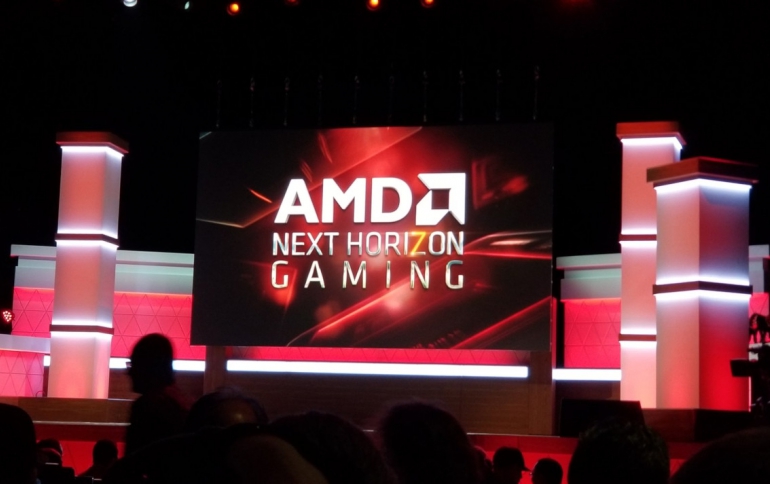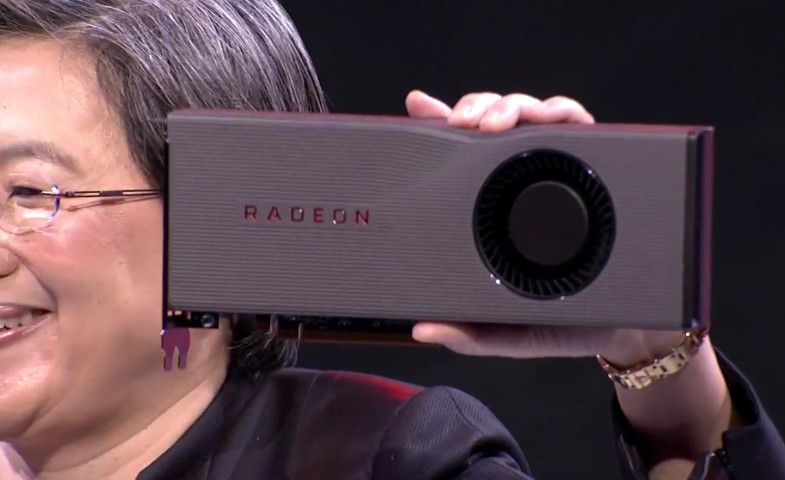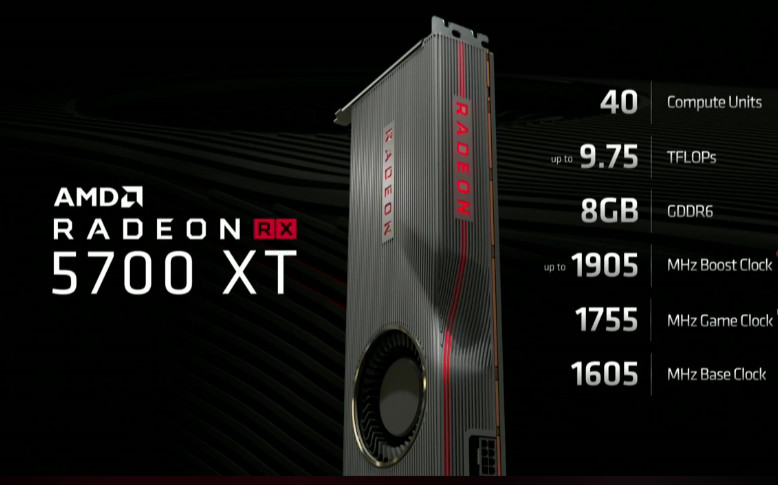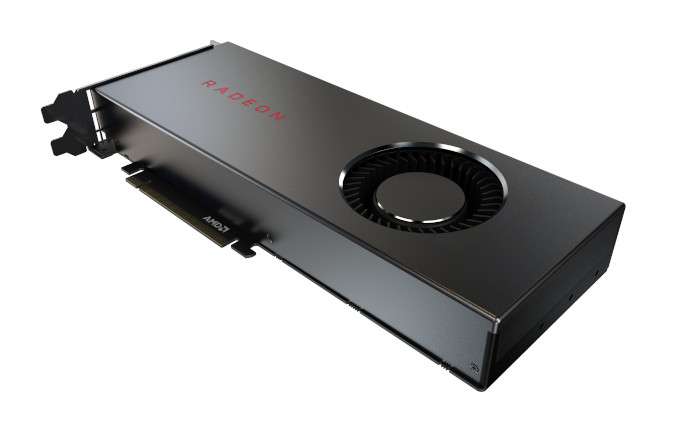
E3: AMD Unveils the Radeon 5700 Graphics Cards, 16-core Ryzen 3950X Gaming CPU and More
AMD today held its Horizon Gaming event at E3 and announced the Radeon RX 5700 series of graphics cards, along with the world's first 16-core CPU for gaming, the Ryzen 3950X.
“We’ve made significant technology bets to push the envelope on high-performance computing and give gamers the hardware they need to power the experiences they want,” said Dr. Su. “Our industry-leading Ryzen 3000 Series desktop processors and Radeon RX 5700 Series graphics cards combine leadership design, performance, technology, and efficiency to provide the ultimate gaming experiences. From super-fast frame rates, to new levels of visual realism and image quality, or the ability to easily create, capture and share gaming experiences, PCs featuring our new Ryzen processors and Radeon GPUs offer exceptional performance and features for every gamer at every price point.”
“Seventy percent of PC gamers today are using three-year-old or older graphics hardware that lacks the necessary horsepower and capabilities to deliver fully immersive, high-fidelity and high-performance gaming experiences,” said Scott Herkelman, corporate vice president and general manager, Radeon Technologies Group at AMD. “Our new Radeon graphics cards with RDNA redefine what’s possible in 1440p gameplay, delivering stunning visuals, amazing performance and industry-leading features to take gaming experiences to the next level.”

Radeon RX 5700

AMD talked about its first 7-nanometer "Navi" GPUs a few weeks ago at Computex, the Radeon RX 5000 series. Today the company provided at E3 more details.
The first cards from the new "RDNA" architecture will be the $449 Radeon RX 5700 XT, which will take on NVIDIA's RTX 2070, and the $379 RX 5700, which competes with the NVIDIA RTX 2060. Both new cards target mid-range performance and 1440p gaming and AMD is still offers the Radeon VII for the high-end segment.
The RDNA gaming architecture features a new compute unit design optimized for improved efficiency, and a multi-level cache hierarchy designed to provide reduced latency, higher bandwidth and lower power. It also includes a streamlined graphics pipeline that is optimized for performance-per-clock and high clock speeds.
Delivering up to 1.25X higher performance-per-clock and up to 1.5X higher performance-per-watt compared to the previous-generation Graphics Core Next (GCN) architecture, RDNA provides the computational horsepower to enable gaming with enhanced explosions, physics, lighting effects, along with fluid, high-framerate gaming.
RDNA also enables DisplayPort 1.4 with Display Stream Compression (DSC) to deliver extreme refresh rates, color depth and resolutions up to 8K HDR at 60Hz or 4K HDR at 144+ Hz on cutting edge displays, including the first monitor to support DSC: the new ASUS Republic of Gamers 43-inch monitor previewing at E3. The new monitor is capable of delivering 4K HDR at 144Hz with a single DisplayPort 1.4 cable.



The Radeon RX 5700 XT will feature 40 compute units with 2,560 stream processors, and mount 8GB of GDDR6 memory using a 256-bit memory bus. That gives the 5700 XT memory bandwidth in the neighborhood of 448GBps. AMD said the 5700 XT features 9.75 TFLOPS of compute performance. The 5700XT has a board power rating of 225 TDP and is powered by a 6-pin GPU and 8-pin GPU plug. More importantly, the Radeon RX 5700 XT will sell for an affordable $449. The company claims that the card outperforms the RTX 2070 by around 20 FPS in 1440p.
AMD’s 2nd Navi-based GPU is the Radeon RX 5700. It features 36 compute units, 2,304 stream processors, and will have 8GB of GDDR6 memory on a 256-bit bus for 448Gps. Its compute performance is rated at 7.95 TFLOPs. The Radeon RX 5700 will go for $379.
The Radeon RX 5700 XT features a boost clock of 1,905MHz, a new “game clock” of 1,755MHz, and a base clock of 1,605MHz.
The Radeon RX RX 5700 has a boost clock of 1,725MHz, “game clock” of 1,625MHz, and a base clock of 1,475MHz.
AMD said it is targeting “game clock” based on a list of popular games to maintain the clock speeds. Boost clock would be opportunistically hit based on the load the GPU is running at. AMD says that it’s more about targeting clock speeds that benefit games. In practical performance, most games will hang around at the game clock and only occasionally hit the boost clock. The base clock speed is unlikely to be triggered unless you’re running an extreme stress test.
Both cards will be available on July 7th.


| Model | Compute Units |
Stream Processors |
TFLOPS | GDDR6 (GB) |
Base Clock (MHz) |
Game Clock (MHz) |
Boost Clock (MHz) |
SEP (USD) |
|
| Radeon RX 5700 XT 50th Anniversary Edition |
40 | 2,560 | Up to 10.14 | 8 | 1,680 | 1,830 | Up to 1,980 | $499 | |
| Radeon RX 5700 XT | 40 | 2,560 | Up to 9.75 | 8 | 1,605 | 1,755 | Up to 1,905 | $449 | |
| Radeon RX 5700 | 36 | 2,304 | Up to 7.95 | 8 | 1,465 | 1,625 | Up to 1,725 | $379 | |
With ray tracing available on GeForce RTX, gamers have been wondering what AMD’s plans are for the technology. AMD officially said the path they see includes using the current GCN and RDNA cards to perform ray tracing using the card’s shader cores. When Next Gen RDNA comes along, “select lighting effects for real time gaming” will be used.
That sounds like a future RDNA will accelerate certain DXR techniques for lighting, similar to the way Nvidia’s GeForce RTX mixes conventional rasterized rendering and ray tracing.
Beyond that, AMD doesn’t seem to think full scene ray tracing can be done on a PC. Instead, the company said full scene ray tracing will likely be done in the cloud--which, well, sounds like streamed gaming.
When gamers buy Radeon RX 5700 series graphics cards, they'll get three-month access to Xbox Game Pass for PC, including access to Gears 5.
AMD CEO Lisa Sue also also unveiled a $499 50th anniversary edition of the 5700XT, which will feature boost speeds up to 1.98GHz, as well as a unique gold trim.

New features in the Radeon 5700 cards include FidelityFX, an open source toolkit that can improve visual quality, like making the roads in a racing game sharper. Radeon Image Sharpening will offer a similar visual upgrade for games that don't support FidelityFX, and AMD says both features won't impact performance. Esports players will also appreciate Radeon Anti-Lag, which helps to reduce lag between your GPU and monitor. In an on-stage demo, the feature managed to drop around 15ms worth of lag compared to NVIDIA's RTX 2070.
AMD is working with game and game technology developers to unlock new experiences in PC gaming and supercharge Radeon graphics performance on today’s most popular titles. At the Next Horizon Gaming event, Dr. Su was joined by The Game Awards creator Geoff Keighley and leaders from the world’s top game and game technology developers, including head of The Coalition Studio, Rod Fergusson; The Coalition technical director, Mike Rayner; president, CEO and co-founder of Gearbox Software, Randy Pitchford; co-founder and CEO of Ubisoft, Yves Guillemot; executive producer of Tom Clancy’s Ghost Recon Breakpoint at Ubisoft, Nouredine Abboud; and vice president of graphics at Unity Technologies, Natalya Tatarchuk.
They provided exclusive looks at never-before-seen game content, including Gears 5, Borderlands 3,Tom Clancy’s Ghost Recon Breakpoint, and Unity’s The Heretic technology demo, showcasing the PC gaming experiences enabled by new AMD products and technologies.
AMD's $749 Ryzen 9 3950X CPU packs 16 cores for gaming
AMD also announced it's pushing gaming beyond 8- or 12-cores, with the "world's first 16-core gaming CPU," the Ryzen 9 3950X.

The CPU has 16 cores, 32 threads, it is clocked at 3.5 GHz and hits the 4.7GHz (boost). It comes with 72MB of cache and draws 105 watts power. It will be available in September for $749.
As a reminder, Intel's best gaming CPU has 8 cores.
AMD says that while 40 percent of its speed and efficiency boosts can be attributed to the smaller 7nm circuitry, 60 percent is the new design of its Zen 2 cores, which offer a 15 percent boost over the previous Zen architecture clock for clock.
The smaller process yields sizable power efficiency increases. For example, AMD said a Ryzen 7 3700X offers 75 percent more performance than a Ryzen 2700X in Cinebench R20 multi-threaded tests. During that test, the Ryzen 7 3700X consumes 135 watts at the wall, while the Ryzen 7 2700X demands 195 watts.
AMD said the Zen 2 cores yield a 21 percent performance increase over the Zen+ cores with roughly 40 percent of that coming from the process and and 60 percent of it from IPC improvements.
In the move from 12nm to 7nm process, however, AMD redesigned the x86 core’s innards, adding a new front-end with improved branch predictor, better instruction pre-fetching, and larger caches. The 7nm Zen 2 cores basically feature double the floating point performance over 12nm Zen+ cores, yielding a 25-percent increase in performance for the same power as the Zen+ chip.
AMD has also worked hard to address one of the issues it’s had with memory latency. By moving from DDR4/2667 to DDR4/3600, many games yield up to double-digit performance bumps.
With Ryzen 3000 chips, the L3 cache basically gets doubled in size. For example, the 12-core Ryzen 9 3900X features a 70MB of cache. That all adds up to a sizeable boost in gaming performance, especially at lower resolutions, AMD said.
As of the Windows 10 May 2019 Update, AMD said optimizations to the operating system will dispatch work to adjacent cores on the same die first, which will reduce latency. AMD also said the May 2019 Update will bring faster clock ramping in its chips. With previous builds of Windows, AMD said it could take around 30 milliseconds for the CPU to ramp up to higher frequencies. As of the update (and with a new chipset driver) it’ll take just 1 to 2 milliseconds for the chip to reach its top speed. These fixes give some games a boost of 15 percent, while the faster clock ramping can yield 6-percent improvements.
In an on-stage demo, AMD said that even though Intel and AMD might play games at the same framerate, only the AMD chip can let you stream ultra high-quality video to your Twitch audience at the same time.
And then there’s AMD’s claim that it’s added so much cache to these chips that we’re talking about CPUs that can actually make games run meaningfully faster.
| Model | Cores/ Threads |
TDP10 (Watts) |
Boost/Base Freq. (GHz) |
L2 + L3 Cache (MB) |
PCIe 4.0 Lanes (processor+AMD X570) |
SEP11 (USD) |
Expected Availability |
|
| Ryzen 9 3950X CPU | 16/32 | 105W | 4.7/3.5 | 72 | 44 | $749 | September, 2019 |
|
With the aid of liquid nitrogen, the AMD Ryzen Overclocking Team managed to push the AMD Ryzen 9 3950X processor to 5.375 GHz, achieving record-setting performance with a Cinebench R20 multi-thread score of 12,167. The Ryzen 9 3950X processor now holds the crown in two important dimensions: highest performance for any 16-core processor and highest performance in a mainstream CPU socket. A new and improved AMD Ryzen Master Software utility was also revealed, including a redesigned user interface and new enthusiast-first overclocking features, offering users an easy way to squeeze every drop of performance from their AMD Ryzen desktop processor powered system.
The 16-core CPU will fit into almost any existing AM4 motherboard, thanks to AMD’s work designing a 12-layer substrate to route each of the new, smaller 7nm process circuits to the existing AM4 pins.
And AMD says it plans to keep offering that kind of backward compatibility through 2020 and for the foreseeable future, instead of making you buy a new board alongside your next CPU upgrade.
AMD’s also throwing in high-end stock coolers with each of the new CPUs, with every Ryzen 7 and 9 coming with the RGB LED-lit Wraith Prism cooler, which should support Razer Chroma lighting to sync up with your mouse, keyboard and other gaming gear.
The integrated graphics ‘APU’ line of processors from AMD is a popular entry point for consumers on a budget based on the good performance from the cores, gaming-capable graphics, and all for a reasonable low cost that also comes bundled with a very sufficient cooler.The new Ryzen 3000 APUs are built on last generation Zen+ 12nm technology, but with increased IPC, clock speeds, and an overall performance bump.
On July 7th, AMD will launch its new Zen+ APUs.
| Cores | Base Freq |
Turbo Freq |
IGP | IGP Freq |
DDR4 | TDP | Price | |
| Ryzen 3000 'Zen+' | ||||||||
| Ryzen 5 3400G | 4C / 8T | 3.7 | 4.2 | Vega 11 | 1400 | 2933 | 65W | $149 |
| Ryzen 3 3200G | 4C / 4T | 3.6 | 4.0 | Vega 8 | 1250 | 2933 | 65W | $99 |
| Ryzen 2000 'Zen' | ||||||||
| Ryzen 5 2400G | 4C / 8T | 3.6 | 3.9 | Vega 11 | 1250 | 2933 | 65W | $159 |
| Ryzen 3 2200G | 4C / 4T | 3.5 | 3.7 | Vega 8 | 1100 | 2933 | 65W | $99 |
The Ryzen 5 3400G and Ryzen 3 3200G replace the 2400G and 2200G counterparts in the product line and offer two new speed jumps. The Zen+ architecture used in the new CPUs will offer a raw +3% throughput increase (IPC) in compute performance, as we saw when the main processor line moved from Zen to Zen+. The other factor is frequency – both new CPUs gain +300 MHz on the turbo frequency compared to the previous generation, as well as a +150 MHz increase in graphics frequency, all at the same power budget. The new APUs also support DDR4-2933, which will help with performance.
The Ryzen 5 3400G will not only be released $10 lower than the 2400G, but it will now come with the 95W AMD Wraith Spire CPU cooler bundled in box, an upgrade over the 65W version previously used. This CPU will also be Indium-Tin soldered on for better thermal performance and potential in overclocking headroom.






















